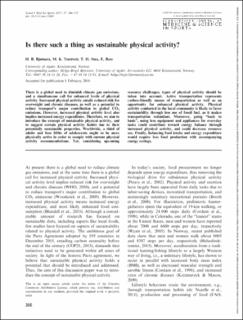| dc.contributor.author | Bjørnarå, Helga Birgit | |
| dc.contributor.author | Torstveit, Monica Klungland | |
| dc.contributor.author | Stea, Tonje Holte | |
| dc.contributor.author | Bere, Elling | |
| dc.date.accessioned | 2016-11-23T13:45:09Z | |
| dc.date.accessioned | 2017-01-31T08:34:45Z | |
| dc.date.available | 2016-11-23T13:45:09Z | |
| dc.date.available | 2017-01-31T08:34:45Z | |
| dc.date.issued | 2016 | |
| dc.identifier.citation | Scandinavian Journal of Medicine & Science in Sports 2016 | nb_NO |
| dc.identifier.issn | 0905-7188 | |
| dc.identifier.uri | http://hdl.handle.net/11250/2428986 | |
| dc.description | - | nb_NO |
| dc.description.abstract | This study aims to assess the prevalence of different modes of commuting to school and work for 10-12year-olds and their parents; to assess the associations with demographic variables (country, sex, parental education and ethnicity) and with weight status in eight European countries. As part of the ENERGY project a cross-sectional survey was conducted in 2010 in which modes of commuting and socio-demographic variables for children (N=7903) and one of their parents (n=6455) were measured by questionnaires. Children's weight and height were objectively measured; parents self-reported their weight and height. Logistic multilevel regression analyses assessed the associations between mode of commuting and overweight. Differences between countries and differences in mode of commuting according to demographic variables were tested using χ2-test and Marascuilo's Post-hoc analysis. There were marked differences between countries, especially regarding cycling to school, which was common in The Netherlands and Norway and rare in Greece and Spain. Demographic variables were associated with mode of commuting in children and parents. Mode of commuting was not associated with being overweight in children, after adjustment for demographic variables. Bicycling to work, but not other modes of commuting, was significantly inversely associated with being overweight among parents (OR=0.74 (95%CI 0.57-0.97)). Interventions targeting active commuting may promote cycling, and should take into account the differences regarding demographic variables. | |
| dc.language.iso | eng | nb_NO |
| dc.rights | Navngivelse 4.0 Internasjonal | * |
| dc.rights.uri | http://creativecommons.org/licenses/by/4.0/deed.no | * |
| dc.title | Is there such a thing as sustainable physical Activity? | nb_NO |
| dc.type | Journal article | nb_NO |
| dc.type | Peer reviewed | nb_NO |
| dc.date.updated | 2016-11-23T13:45:09Z | |
| dc.rights.holder | © 2016 The Author(s) | |
| dc.identifier.doi | 10.1111/sms.12669 | |
| dc.identifier.cristin | 1365423 | |
| dc.description.localcode | Nivå2 | |

